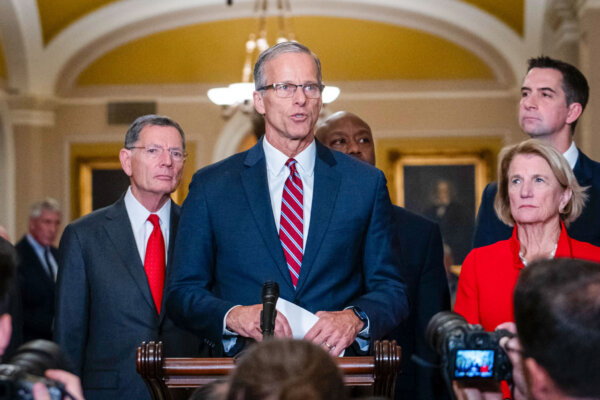![]() Incoming Senate Majority Leader John Thune (R-S.D.) has responded to a question about President-elect Donald Trump’s selections for his cabinet and the likelihood of those individuals being confirmed by the Senate, saying he isn’t taking recess appointments off the table.
Incoming Senate Majority Leader John Thune (R-S.D.) has responded to a question about President-elect Donald Trump’s selections for his cabinet and the likelihood of those individuals being confirmed by the Senate, saying he isn’t taking recess appointments off the table.
Before being elected as the Senate majority leader, Thune issued a statement that he would allow for “recess appointments,” as Trump suggested.
This week, Trump has selected a number of individuals to join his Cabinet that Democratic lawmakers took issue with, including Robert F. Kennedy Jr. to lead the Department of Health and Human Services, Matt Gaetz to lead the Department of Justice, Tulsi Gabbard as director of national intelligence, and Pete Hegseth to lead the Department of Defense. Some Republican lawmakers also appeared to take issue with some of Trump’s choices, namely Gaetz.
When asked about some of the Cabinet selections, Thune said he hopes the upper chamber does not have to use recess appointments.
“Hopefully, it doesn’t get to that, but we’ll find out fairly quickly whether the Democrats want to play ball or not,“ he said, adding that ”all options are on the table, including recess appointments.”
“You have to have all Republicans vote to recess as well. So the same Republicans you mentioned who might have a problem voting for someone under regular order probably also have a problem voting to put the Senate into recess. You have to have concurrence from the House.
“There’s a process, all of this is a process. But I don’t think any of those things are necessarily off the table.”
Sen. John Cornyn (R-Texas), who ran against Thune for the majority leader position and lost, had suggested he would be open to recess appointments following Trump’s statement.
How do Recess Appointments Work?
The Senate, as set up by the U.S. Constitution, holds a role in confirming—or rejecting—high-level officials including Cabinet positions, judges, and ambassadors. It’s part of the government’s checks and balances that ensure the president does not get to rule unilaterally. However, there is a clause in the Constitution that allows presidents to fill out their administrations while the Senate is in recess.
During the nation’s early history, Congress would take months-long breaks from Washington, and presidents could use recess appointments to avoid having an important job go unfilled. But more recently, the process of recess appointments has been featured in partisan fights with the president.
The Supreme Court unanimously ruled that the Senate has to recess or adjourn for 10 days before a president can make unilateral appointments. That has resulted in a practice where the Senate still holds pro-forma sessions where one senator opens and closes the chamber, but no legislative business is conducted.
The House also holds some power over recess appointments by refusing to allow the Senate to adjourn. Projections from The Associated Press show that Republicans will also have a majority in the lower congressional chamber.
Republican senators will likely start hearings on Trump’s Cabinet selections when the new Congress is sworn in on Jan. 3, 2025. Trump, meanwhile, will be sworn in for a second term on Jan. 20, 2025.











